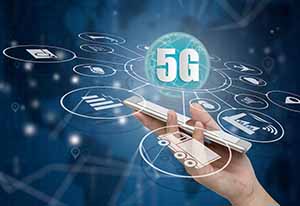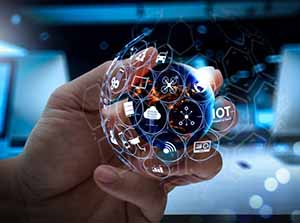In 2022, there were 15.14 billion devices connected to the Internet of Things (IoT), which is a network of connected gadgets. That figure is projected to increase to around 29 billion by 2030. The IoT is revolutionising every business imaginable as it merges the physical and digital worlds by opening up new opportunities, upgrading the consumer experience, enhancing productivity, efficiency, and agility, and facilitating intelligent decisions. The possibilities of the IoT are limitless, from utilising drones to scan farmlands to tracking commodities through a supply chain with sensors and RFID tags to improving banking experiences with linked user devices. Traditional information systems and network administration methods are being quickly replaced by the Internet of Things (IoT) and network software. Smart cities, urban computing, omnipresent healthcare, and tactile Internet are just a few examples of where the Internet of Things is being used and used. The physical architecture of heterogeneous network systems has gotten more complex as a result, necessitating effective and dynamic management, configuration, and flow scheduling solutions. In recent years, there has been a lot of research towards network softwarization for the Internet of Things, namely Software Defined Networks (SDN) and Network Function Virtualization (NFV).
IoT – as Tool of Business Transformation

Before using IoT as a tool for business transformation, however, businesses must meet a number of prerequisites. One is that, like other software programmes, the Internet of Things must be included into goods and procedures. Second, iteration is the key to successful IoT adoption: Organisations must collect data from devices, analyse it, act on the results, and repeat the process in a continuous feedback loop to continuously improve the many IoT constituents. This is necessary because the IoT consists of a wide range of components. This implies that organisations need to develop plans for ongoing administration, maintenance, and updating of the linked systems, processes, and equipment. And they must test everything to make sure that all the “things” can communicate with one another and that their performance satisfies requirements and meets user expectations. The IoT market has $465 billion in revenue in 2019 and is projected to reach $1.5 trillion in 2030. Sixty-six percent of IoT investment will go towards services, software, cloud, and apps that include connectivity, with the remaining sum going towards hardware in the form of specialised IoT devices, modules, and gateways. A McKinsey and Gartner.com IoT projection claims that from 13 percent in 2014 to roughly 25 percent today, enterprises are using IoT technologies. By 2023, 43 billion IoT-connected devices are expected to be in use worldwide, an increase of almost three times what it was in 2018. It’s an industrial revolution similar to the one that began with electricity in 1914 and went on to include the internet in every gadget. Our homes and businesses will undergo a significant transformation as a result of faster cloud computing power and the arrival of 5G.

The number of IIoT connections worldwide is expected to rise from 17.7 billion in 2020 to 36.8 billion in 2025, an increase of 107 percent, Several studies have identified the IIoT market’s primary growth sector for the following five years as being smart manufacturing. Forbes estimates that by 2026, the worldwide security business would be worth $270 billion, with 77 percent of companies investing in externally managed security services. Your chosen IoT platform package should include regular security updates. According to a report from Digitalist, by 2025, the economic impact of the IoT could be $11 trillion, or 11% of the value of the world economy. The internet of things market size is also continuing to increase, with clear economic significance. According to Statista, by 2025, the global IoT industry will reach $1.6 trillion. By 2022, according to predictions from International Data Corporation, spending on consumer and industrial IoT equipment and services would reach more than $1 trillion, rising at a double-digit rate. The possibility is enormous, and like electricity, Windows and Mac OS, computers, mobile devices, and IoT will become a natural part of our lives.
Device Testing and Virtualization
The virtual machines replicate everything from device start up to configuration setting manipulation and communication between devices and the cloud in both directions. It is possible to practically simulate different loads and network-related circumstances to evaluate an application’s performance. Through device virtualization, any sort of device, whether in the prototype or production stages, may be emulated. When early input from virtual devices can be used to eliminate problems or fix performance issues earlier in the development cycle and at a cheaper cost, they are especially helpful. Benefits from device virtualization can be enormous. A financial services company reduced the length of its nightly feedback loop for regression cycles from 1,500 hours when it used sequential testing to just 7.5 hours. Last but not least, 50 to 60 percent of testing needs can be automated using virtual devices. Dassault Aviation, which introduced a business jet without building a physical prototype, is a good example in this regard. The company’s international developer network reduced assembly time and tooling costs significantly by working on a virtual platform and shared database.
Improving IoT solution and development outcomes

Device virtualization can enhance the quality and delivery of IoT solutions when combined with IoT platform engineering. One of the main drivers of the Internet of Things revolution is the accessibility of powerful, reasonably priced devices. IoT systems must therefore integrate new software advancements while simultaneously keeping up with the development of physical components. The issue is that hardware enters the IoT platform development cycle far later than it should, which increases prices, lowers quality, and extends lead times. Device virtualization enables the introduction of hardware at an early stage of platform development—even during the application design phase—and assures that it is available at all times. This has numerous advantages for the development of IoT solutions. Last but not least, by checking a variety of characteristics, such as scalability, resource utilisation, and security, device virtualization enhances feature validation and testing outcomes.
Conclusion
IoT and AI have a promising future, and both are anticipated to have a substantial impact on global economic development. Although there are obstacles to be solved, there is a wide range of possible advantages to these technologies. The first Internet of Things (IoT) devices were made with built-in business logic. They were used for specific jobs like the control of machinery, power plants, or trains. They were designed to carry out a single fixed purpose. Today, however, gadgets are relatively unfinished when they are released, and the cloud is then used to provision their capabilities. The advantages of consolidation, valuable flexibility for IoT, and built-in security are all provided by embedded virtualization. Deploying IoT systems and ensuring their smooth operation presents numerous technological obstacles. These consist of intelligence analysis and activities, standards, security, connection, compatibility and lifespan, and compatibility. Large, mobile, and continually changing in topology and connection, IoT networks are typical. Additionally, they have heterogeneous devices that can run a variety of applications. In order to deploy IoT devices on a broad scale, problems including IoT device detection, low power consumption, bandwidth, access control, and data encryption become crucial issues.












